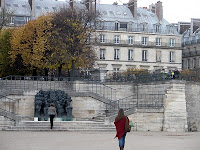
We started the day with a stroll along rue Lepic, a delightful street with a real Parisian flavour. It is on the other side of the hill on which Sacre Coeur stands and near the Montmartre cemetery where a great many of the famous and infamous are buried. Although not as popular a site to visit as some of the other cemeteries around Paris, fans of Toulouse-Lautrec should make it a point of call just to see the grave of La Goulue, the dancer who featured in his first poster of the Moulin Rouge. He was said to have proudly announced, "my poster is pasted today on the walls of Paris." Others buried there include Nijinsy, Zola, Degas and Berlioz.
We are rather proud of our ability to get around Paris these days, having become familiar with the buses, the Metro, and to a lesser extent the RER. Having a Navigo card makes it that much easier, allowing us to hop on and off as well as between the various modes of transportation. Every so often, we realize that we are quite fortunate in that we are rarely out during rush hour and actually don't have to do too much changing of lines on the Metro. The Metro proudly claims that it is uncommon to have to make more than one change to get wherever it is you are going.
Today, everything that can make a trip difficult hit us at once. A bit of background first. We have friends in the 16eme Arondissment which is a reasonable distance from us. When we visited them before, we took the Metro into the centre of Paris, hopped on a bus which took us along the Seine, and then walked a fairly strenuous up-hill street to their home. This time since Virginia was at school, and I was at home, we came from separate directions although on the same line. We agreed to meet at a bookstore (W. H. Smith's) near Concorde. The trip there, coming from different directions on the No. 12 Metro line, was taken in the height of rush hour and when we each arrived (within minutes of each other) it was pouring and night had fallen. Fortunately, intrepid travellers that we are, we had each packed our "brollies" with us.
Back we went to the station at Concorde, this time to take the No. 1 line to Franklin Delano Roosevelt station, a distance of only two stops, but on a line taking people home from the city. It was packed. I recently read that during rush hour on the London Underground, riding on the tube was the equivalent of packing four people into a moving telephone box. Well, the French must have taken this to heart in their on-going war with the British; this was like travelling in a telephone box with at least six people in it. Now we had to make our second change. This time to line No. 9. Five stops later we were at La Muette. As we came to the surface, we prided ourselves on our successful trip; only to realize we were well ahead of the appointed time and it was still raining.
Fortunately the Metro station is near a number of shops so we did what one does in such a situation and went into a cafe - rather elegant at that - and had a glass of wine and an espresso.

When we finished we upped umbrellas and walked the short distance to our friends. There, once in the building, we took the elevator to their floor. Now we have all seen films - particularly horror films - in which the classic French lift (small, open sided) creaks its wayslowly to the floor while the bad guys run up the stairs. Well, this is that classic lift except that instead of slowly creaking its way upwards; once the double set of doors is closed and the button pressed, it starts with a bang and goes like a rocket. It stops with another bang and once again you untangle yourself through the doors (how you do this with a load of shopping is anyone's guess) you have arrived.
A wonderful warm welcome awaited us from our friends and their dog, Babette. Did you know that in France the name of a dog must start with a first letter designated by the government based on the month of the year in which the animal is registered. This did not seem to bother Babette in the least as she ate the peanuts and whatever else she could get to while enthusiastically enjoying herself. We too enjoyed a delightful dinner and lots of good talk with our friends. What could be a nicer way to spend an evening anywhere in the world. Then it was back to the Metro and home. Fortunately it had stopped raining and the trip was uneventful.

















































